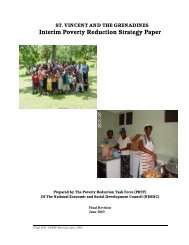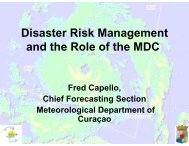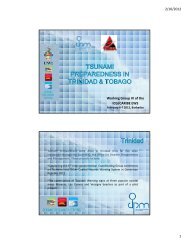The Anatomy of A Silent Crisis The Anatomy of A Silent Crisis
The Anatomy of A Silent Crisis The Anatomy of A Silent Crisis
The Anatomy of A Silent Crisis The Anatomy of A Silent Crisis
- TAGS
- anatomy
- www.bb.undp.org
You also want an ePaper? Increase the reach of your titles
YUMPU automatically turns print PDFs into web optimized ePapers that Google loves.
84 Forum 2009: Climate Change – <strong>The</strong> <strong>Anatomy</strong> <strong>of</strong> a <strong>Silent</strong> <strong>Crisis</strong><br />
B. Attribution <strong>of</strong> weather-related disasters to climate change<br />
Basic reasoning behind methodology<br />
<strong>The</strong> frequency and intensity <strong>of</strong> weather-related disasters is <strong>of</strong>ten associated with climate change<br />
in public debate and common perceptions. In its Fourth Assessment Report, the IPCC found that<br />
weather patterns have become more extreme, with more frequent and more intense rainfall events,<br />
more intense heat waves and prolonged droughts. However, there is not yet any widely accepted<br />
global estimate <strong>of</strong> the share <strong>of</strong> weather-related disasters that are attributable to climate change. A<br />
range <strong>of</strong> regional studies will be discussed at the end <strong>of</strong> this section; but these are hard to generalize<br />
to the global level. While there are many connections between physical linkages from the physical<br />
changes caused by climate change to weather-related disasters, there are also significant challenges<br />
in estimating the attribution. First <strong>of</strong> all, natural variability and socio-economic factors have an impact<br />
on the frequency and scale <strong>of</strong> natural disasters. This means that the increase in weather-related<br />
disasters over the past decades cannot be entirely attributed to climate change.<br />
<strong>The</strong> attribution estimates in the Human Impact Report rely on a simple but powerful approach<br />
to separating climate change from factors not related to climate change. <strong>The</strong> natural variability <strong>of</strong><br />
disasters is best taken into account by considering as long a period <strong>of</strong> available reliable data as<br />
possible. Factors other than natural variability are also considered. Geophysical disasters, such as<br />
earthquakes, are also subject to natural variability but they are clearly not impacted by the climate.<br />
<strong>The</strong> trend in such disasters can be considered as a proxy for factors not related to climate, for<br />
example the quality <strong>of</strong> monitoring <strong>of</strong> disasters. A comparison <strong>of</strong> the trend in weather-related disasters<br />
to the trend geophysical disasters can provide an indication <strong>of</strong> the share <strong>of</strong> weather-related disasters<br />
attributable to climate change. If climate change is causing an increase in weather-related disasters<br />
we would expect the trend in weather-related disasters to exceed the trend in geophysical disasters.<br />
Approach applied<br />
<strong>The</strong> approach <strong>of</strong> comparing the trends in weather-related and geophysical disasters is based on<br />
an analysis <strong>of</strong> loss-generating events in the publication Journal <strong>of</strong> Flood Risk. 5 <strong>The</strong> article states that<br />
by “Assuming the socio-economic driving factors behind loss-generating events to be the same for<br />
all causes, the difference is likely to be due to climate change”. <strong>The</strong> validity <strong>of</strong> the approach has been<br />
reviewed with a number <strong>of</strong> experts. While it is a rough approach, particularly on shorter time series,<br />
it is seen as comparatively strong. Alternative analyses <strong>of</strong> number <strong>of</strong> affected, recorded losses <strong>of</strong><br />
property and insured losses are associated with greater uncertainty than the frequency <strong>of</strong> events.<br />
Key indicators<br />
• Numbers <strong>of</strong> loss-generating events — floods, windstorms, earthquakes.<br />
• Trend in loss-generating events — floods, windstorms, earthquakes.<br />
• Share <strong>of</strong> weather-related disasters attributable to climate change.







